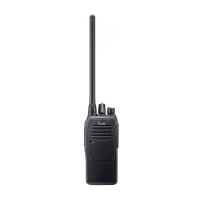4-17
4-4 RECEIVE ADJUSTMENTS (CONTINUED)
1) Select an adjustment item using [↑]/[↓]/[←]/[→] on the PC’s keyboard.
2) Set or modify the adjustment value as specified using [Space]/[Back Space] on the PC’s keyboard.
ADJUSTMENT
TRANSCEIVER’S
CONDITION
OPER ATION
ADJUSTMENT
ITEM
VALUE
SQUELCH
- Verification -
Wide*
3
(Band low)
9 • CH No.: 44
• Receiving
• Set the SSG as:
Frequency:
[400~470 MHz versions]
400.050 MHz
[450~512/520 MHz versions]
450.050 MHz
Deviation: ±3.0 kHz
Level
†
: –10 dBµ (–117 dBm)
– Squelch opens.
10 • Turn OFF the SSG output. Squelch closes.
(Band center) 11 • CH No.: 45
• Receiving
• Set the SSG as:
Frequency:
[400~470 MHz versions]
435.050 MHz
[450~512/520 MHz versions]
485.050 MHz
Level
†
: –10 dBµ (–117 dBm)
Squelch opens.
12 • Turn OFF the SSG output. Squelch closes.
(Band high) 13 • CH No.: 46
• Receiving
• Set the SSG as:
Frequency:
[400~470 MHz versions]
469.950 MHz
[450~512/520 MHz versions]
519.950 MHz
Level
†
: –10 dBµ (–117 dBm)
Squelch opens.
14 • Turn OFF the SSG output. Squelch closes.
RECEIVE AUDIO
DISTORTION
- Verification -
1 • CH No.: 41
• Receiving
• Set the SSG as:
Frequency:
[400~470 MHz versions]
400.050 MHz
[450~512/520 MHz versions]
450.050 MHz
Level
†
: +60 dBµ (–47 dBm)
Deviation: ±1.5 kHz
• Connect the distortion meter to [SP]
through the JIG cable 2
• Adjust the AF volume so that the
distortion meter shows the AF
output level to 0.35 W (1.67 V).
– Less than 5%
Continued on the next page…
*
3
No verification is necessary for [USA].
†
The output level of the standard signal generator (SSG) is measured at the load end (PD).

